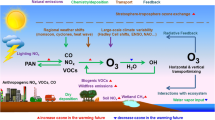Abstract
Results of a comprehensive study of the characteristics of turbulent transport very close to the ground using micrometeorological eddy-covariance measurements from the Cloud Aerosol Interaction and Precipitation Enhancement Experiment (CAIPEEX) Integrated Ground Observational Campaign (IGOC) conducted in 2011 at a rural site over the Indian peninsular region are presented. The dataset used in the present study pertains to the morning hours when the convective boundary layer is at its growing phase. A new method, very similar to the traditional quadrant analysis, is introduced to investigate the relationship between the scalar and momentum flux transports by projecting the scalar and momentum flux contours onto the \(u-w\) plane. Cospectral analysis is employed to study the scales of the transporting eddies; it was found that, during very unstable conditions, the scalar and momentum transports are poorly correlated with each other. However, for the near-neutral case, the correlation between the scalar and momentum transports becomes stronger, thus supporting the Reynolds analogy.












Similar content being viewed by others
References
Betchov R, Yaglom AM (1971) Comments on the theory of similarity as applied to turbulence in an unstably stratified fluids. Izv. Akad. Nauk SSSR, Ser. Fiz. Atmosf. i Okeana 7: 1270–1279 (829–832 in the Engl. transl. of the journal)
Cava D, Giostra U, Siqueira MBB, Katul GG (2004) Organised motion and radiative perturbations in the nocturnal canopy sublayer above an even-aged pine forest. Bound Layer Meteorol 112:129–157
Chandra K (1938) Instability of fluids heated from below. Proc R Soc A 164:231–242
Hinze JO (1959) Turbulence. McGraw-Hill, New York, 586 pp
Kader BA, Yaglom AM (1990) Mean fields and fluctuation moments in unstably stratified turbulent boundary layers. J Fluid Mech 212:637–662
Kaimal JC, Wyngaard JC, Izumi Y, Coté OR (1972) Spectral characteristics of surface-layer turbulence. Q J R Meteorol Soc 98:563–589
Kaimal JC, Finnigan JJ (1994) Atmospheric boundary layer flows: their structure and measurement. Oxford University Press, New York, 289 pp
Khanna S, Brasseur JG (1997) Three dimensional buoyancy and shear-induced local structure of the atmospheric boundary layer. J Atmos Sci 55:710–743
Kulkarni JR, Maheskumar RS, Morwal SB, Konwar M, Deshpande CG, Joshi RR, Bhalwankar RV, Pandithurai G, Safai PD, Narkhedkar SG, Dani KK, Nath A, Sapre VV, Puranik PV, Kandalgaonkar S, Mujumdar VR, Khaladkar RM, Vijayakumar R, Prabha TV, Goswami BN (2012) The cloud aerosol interactions and precipitation enhancement experiment (CAIPEEX): overview and preliminary results. Curr Sci 102:413–425
Laubach J, McNaughton KG (2009) Scaling properties of temperature spectra and heat-flux cospectra in the surface friction layer beneath an unstable outer layer. Bound Layer Meteorol 133:219–252
Lemone MA (1973) The structure and dynamics of horizontal roll vortices in the planetary boundary layer. J Atmos Sci 30:1077–1091
Li Dan, Bou-Zeid Elie (2011) Coherent structures and the dissimilarity of turbulent transport of momentum and scalars in the unstable atmospheric surface layer. Bound Layer Meteorol 140:243–262
McNaughton KG, Clement RJ, Moncrieff JB (2007) Scaling properties of velocity and temperature spectra above the surface friction layer in a convective atmospheric boundary layer. Nonlinear Process Geophys 14:257–271
Narasimha R, Kailas SV (1990) Turbulent bursts in the atmosphere. Atmos Environ 24A:1635–1645
Prabha TV, Khain A, Maheshkumar RS, Pandithurai G, Kulkarni JR, Konwar M, Goswami BN (2011) Microphysics of pre-monsoon and monsoon clouds as seen from in situ measurements during CAIPEEX. J Atmos Sci 68:1882–1901
Priestley CHB (1957) Convection from the Earth’s surface. Proc R Soc Lond 238:287–304
Smedman A-S, Högström U, Hunt JCR, Sahlée E (2007) Heat/mass transfer in the slightly unstable atmospheric surface layer. Q J R Meteorol Soc 133:37–51
Tennekes H, Lumley JL (1972) A first course in turbulence. The MIT Press, Cambridge, 300 pp
Vickers D, Mahrt L (1997) Quality control and flux sampling problems for tower and aircraft data. J Atmos Ocean Technol 14:512–526
Acknowledgments
Our sincere thanks to Prof B.N.Goswami, Director, IITM for all his constant encouragement and support, and to all the members of the CAIPEEX-IGOC team specially the workshop people for all possible help. We would also like to thank Dr Johannes Laubach for helping us with the technical details and also to Dr Keith McNaughton for providing help and ideas throughout the research. We are also indebted to two anonymous reviewers and the editor, whose comments were very useful in modifying the manuscript.
Author information
Authors and Affiliations
Corresponding author
Rights and permissions
About this article
Cite this article
Chowdhuri, S., Prabha, T.V., Karipot, A. et al. Relationship Between the Momentum and Scalar Fluxes Close to the Ground During the Indian Post-monsoon Period. Boundary-Layer Meteorol 154, 333–348 (2015). https://doi.org/10.1007/s10546-014-9977-4
Received:
Accepted:
Published:
Issue Date:
DOI: https://doi.org/10.1007/s10546-014-9977-4




